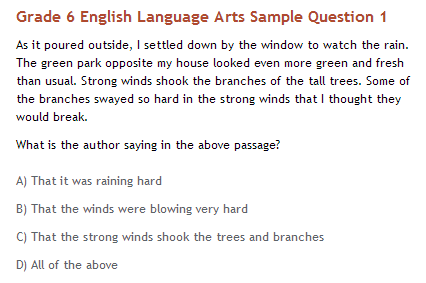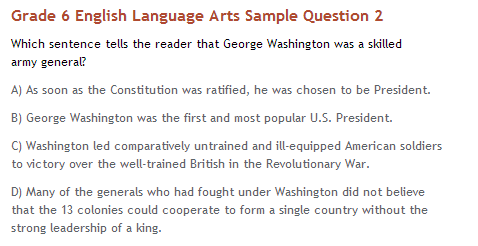Return To Teachers Speak
The upcoming PARCC assessment for ELA will continue to ask students to read passages, answer follow-up questions, and complete writing tasks. However, with this new generation of standardized tests, the format and complexity of those questions will be taken to a new level.

This week we will look at one portion of the ELA assessment – the section that focuses on narrative writing (following the reading of a fictional passages) for Grade 6. While this set of samples is grade-specific, the rationale in creating the questions, the format, and the prerequisite technological skills is universal, regardless of the grade. Three key shifts in the PARCC for ELA are as follows:
New Interconnectedness for Multiple Choice Questions
These two questions follow an excerpt from Jean Craighead George’s novel, Julie of the Wolves:
Part A: Which statement best describes the central idea of the text?
1.Miyax is far from home and in need of help. *
2.Miyax misses her father and has forgotten the lessons he taught her.
3.Miyax is cold and lacks appropriate clothing.
4.Miyax is surrounded by a pack of unfriendly wolves.
Part B: Which sentence best helps develop the central idea?
1.”Miyax pushed back the hood of her sealskin parka and looked at the Arctic sun”.
2.”Somewhere in this cosmos was Miyax; and the very life in her body, its spark and warmth, depended upon these wolves for survival.” *
3.“The next night the wolf called him from far away and her father went to him and found a freshly killed caribou.”
4.“He had ignored her since she first came upon them, two sleeps ago.”
Note that the two questions are closely related, as they both focus on the central idea of the text. In addition, this set of questions reinforces the emphasis on citing evidence, for to be successful with Part B, it is essential that the student reflects on the evidence that he or she used to determine the central idea in Part A. The scoring of these questions is more rigorous as well: students will either receive two points (for answering both questions correctly), or one point for answering Part A correctly. Clearly, this differs from past scoring procedures, where a student could answer any question correctly and receive credit. In this case, by only awarding points for Part B if the first part is accurate ensures that the student “not only made an inference to determine the central idea but also supported that inference with textual evidence” (from http://www.parcconline.org/sites/parcc/files/PARCCSampleItemsELALiteracyGrade6Items081513Final.pdf).
PARCC Test Practice: Online Resources for Educators
Another sample question poses a vocabulary word:
Part A: What does the word “regal” mean as it is used in the passage?
Here, students must identify which choice most accurately describes the meaning of the word. As a follow-up, then, students are asked to go one step further:
Part B: Which of the phrases from the passage best helps the reader understand the meaning of “regal?”
Like the previous set of questions, the second part requires a deeper understanding of the text in order to answer the question correctly. Part B also demands that the reader determine the “context used to establish the accuracy of their answers” (from http://www.parcconline.org/sites/parcc/files/PARCCSampleItemsELALiteracyGrade6Items081513Final.pdf). Finally, the academic vocabulary word in this question is not simply a challenging word; rather, this word has been selected because it reflects vocabulary that is crucial for the reader to understand to fully comprehend the main idea of the passage.
The Introduction of More Options and “Drag and Drop”
This sample question may initially look similar to questions from past tests … until you read the entire question:
Part A Choose one word that describes Miyax based on evidence from the text. There is more than one correct choice listed below (italics added for emphasis).
Like the Mathematics portion of the PARCC, the ELA sections will now provide questions that may have multiple correct responses, which clearly raises the complexity level of the task. In this particular question, the student must consider the many facets of Miyax’s character, which demands that the student have a much more complex understanding of this character, as opposed to simply choosing a single word from a list to describe her.
Parts B and C of this section go one step further:
Part B: Find a sentence in the passage with details that support your response to Part A. Click on that sentence and drag and drop it into the box below.
Part C: Find another sentence in the passage with details that support your response to Part A. Click on that sentence and drag and drop it into the box below.
Clearly, citing evidence is a necessary skill in this portion, too – along with using computer skills for the drag and drop directive. Lastly, questions like these encourage rereading of the text, because it’s not possible to answer the question without at least revisiting some portions of the passage. (from http://www.parcconline.org/samples/english-language-artsliteracy/grade-6-tecr-narrative-writing-task)
The Move Toward Text-Related Writing Prompts
Read through this narrative prompt that follows the questions from the Julie of the Wolves excerpt:
In the passage, the author developed a strong character named Miyax. Think about Miyax and the details the author used to create that character. The passage ends with Miyax waiting for the black wolf to look at her.
Write an original story to continue where the passage ended. In your story, be sure to use what you have learned about the character Miyax as you tell what happens to her next.
This kind of prompt clearly demonstrates the intimate relationship between reading and writing. First, students must apply understanding of Miyax’s character to properly respond to this prompt. Then, it is imperative that they utilize the evidence they gleaned from the parcc reading passages to reflect deep understanding as they weave their knowledge in a new and different way with the writing task.
Remember that this discussion relates to the narrative task only. In future blogs, we will delve more deeply into sample questions that relate to the literary analysis and the research simulation tasks on the assessment. For more sample questions and explanations, visit PARCC’s website at: http://www.parcconline.org/samples/item-task-prototypes.







Greetings! This is my first visit to your blog!
We are a group of volunteers and starting a new initiative in a community in the same niche.
Your blog provided us beneficial information to work on. You have
done a wonderful job!